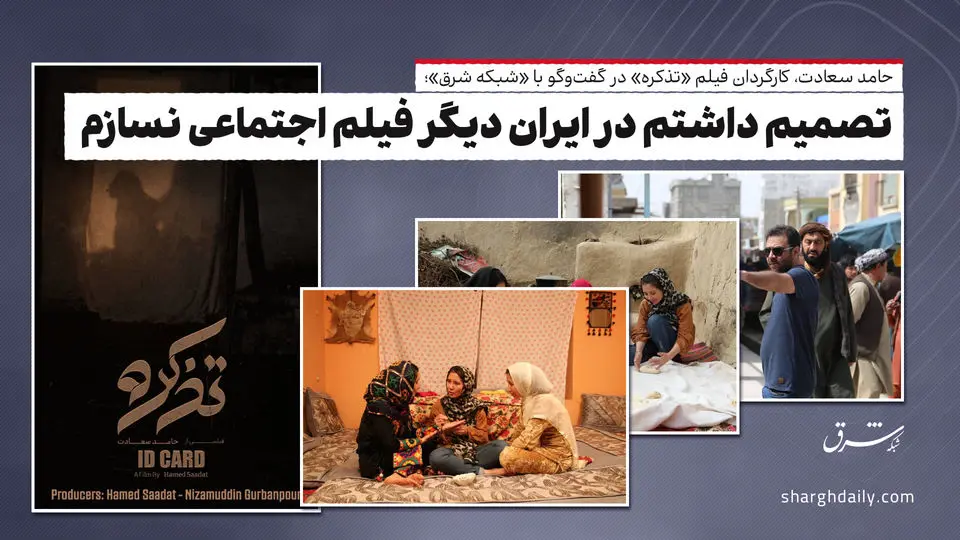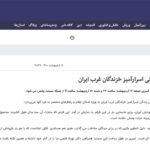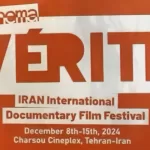SharghDaily: Hamed Sa’adat, director of Afghan Girl’s Journey to Identity, in an interview

I had decided not to make any more social films in Iran
Sa’adat believes that making social films, whether fiction or documentary, has its own set of challenges. Like some of his peers, he had initially decided to move away from this genre.
Hamed Sa’adat, a documentary filmmaker from Kerman, is presenting his latest film, Afghan Girl’s Journey to Identity, to international audiences. The film portrays part of the life of Farzaneh, a girl from an undocumented Afghan immigrant family born in Iran, who returns to Afghanistan to claim her identity. Throughout the documentary, we accompany Farzaneh and see how, in Afghanistan, a woman without a male relative does not possess an independent identity. Understandably, filming in a different geography, especially in Afghanistan, is not an easy task for a documentary crew. Sa’adat believes that making social films, whether in fiction or documentary, has its unique challenges, and like some of his peers, he had decided not to delve into this domain anymore.
Your primary concern in Afghan Girl’s Journey to Identity seems to be highlighting the issue of Afghans born in Iran who lack citizenship. I believe this isn’t the first time you’ve tackled such a topic.
That’s right. My first documentary, Children of the World, dealt with the same issue. During Mahmoud Ahmadinejad’s presidency, Iran withdrew from all international conventions. The Geneva Convention, signed during Hashemi Rafsanjani’s era, stated that children born worldwide, whose parents have migrated, should not be considered illegal immigrants and should be granted identity and education rights. However, Iran withdrew from this convention as well. Years ago, one of the professors at Shahid Bahonar University in Kerman, Dr. Zand, opened a school for Afghan child laborers, where they would attend classes between their work hours. They were genuinely interested in learning, and this became the foundation for my first film.
I think the topic covered in Afghan Girl’s Journey to Identity could have been filmed in Iran to a large extent.
To some extent, you’re right. This subject has been explored multiple times in Iran. On the other hand, I have always been fascinated by the geography of Afghanistan. I wanted the subject to be seen in that environment, so I decided to film it in Afghanistan.
In addition to telling Farzaneh’s story, you also tried to depict Afghanistan’s traditions and customs, such as the Nowruz celebrations or the Buzkashi game, which are intertwined with the narrative about obtaining identity documents. However, at times, these elements seem to deviate from the main story.
First of all, I must point out that sometimes the media presents an incorrect picture of a country. We have always heard narratives about Afghanistan that are sometimes far from reality. The security situation in Afghanistan is not what the media portrays. During the three months we were filming there, it was the peak of the conflict between the Taliban and Ashraf Ghani’s government. After filming, I traveled around Afghanistan for ten days, even going south to Jalalabad. I wanted to show in Afghan Girl’s Journey to Identity that life and traditions continue in Afghanistan.
Naturally, we all know about the issues women face in Afghanistan: they are largely ignored. This is evident in your narrative as well. At times, Farzaneh encounters harsh reactions from people she seeks help from in obtaining identity documents, often conveyed through dialogue. It seems you wanted to highlight Farzaneh’s difficult situation in that context more to the audience, whereas, as a viewer, I would have preferred to see her in situations where these concepts were conveyed through visuals.
Filming challenges in Afghanistan were not few. I think filmmaking in Iran is easier compared to many countries because, at times, one can shoot without a permit. But that wasn’t the case in Afghanistan. Moreover, the corrupt government at the time in Afghanistan made things difficult. Suppose we needed a permit that cost $10; by the time we reached that $10 and paid it, we had to spend $100, which delayed production and increased costs. So if there were instances where we leaned more towards dialogue, it was due to these production challenges. We also faced other issues. Our subject didn’t act. All the situations you see are entirely real.
So, this was truly the real story of this girl?
Yes. In Afghanistan, what we refer to as a family tree is called a “kanda.” There, family trees are still handwritten. If two people testify, saying, for instance, “this is our cousin, born in Iran,” the person’s name is added to the family tree, and then they receive a national ID and identity document. In the film, we see many such cousins whom we could visit.
The last cousin lived in Balkh, but we couldn’t reach him due to the Taliban’s presence there. Interestingly, this cousin from Balkh, unlike the others, was willing to testify so that Farzaneh could get her identity document. If we had made it to Balkh, Farzaneh would have received her identity document, returned to Iran, and would be teaching here instead of being in France now. Nowhere in the film did Farzaneh perform in front of the camera; her situations were entirely genuine.
Why does Farzaneh sometimes speak Persian and at other times in the Afghan dialect?
Whenever she was angry or upset, she spoke in the Afghan dialect. But whenever she was comfortable, she spoke Persian because she was born and raised in Iran. I didn’t try to force her to speak in one way all the time; I thought her comfort in front of the camera was more important.
Over the three months of work in Afghanistan, you must have faced many challenges. After all, filming outside Iran with unpredictable conditions isn’t easy. What was the biggest challenge you faced?
We didn’t bring some equipment from Iran, thinking we’d source it locally. However, the rental costs for equipment were quite high and were calculated in dollars. For example, if the rental for a light in Iran was 50,000 tomans per night, it was $100 per night there. The systemic corruption of the Afghan government at that time greatly affected our work. Getting a permit to film was not an easy task at all.
The working conditions in Afghanistan were very similar to our border regions. However, the people of northern Afghanistan were very cooperative with us.
Was this your first time filming outside of Iran?
No, I had previously made a film in Georgia.
How did it feel to leave Iran and film in a different location or environment?
Even in Iran, I usually don’t film in urban settings. I think people worldwide aren’t that different from each other. All people, if they see honesty, will collaborate with all their hearts. Maybe I’ve been lucky that I haven’t faced any problems while making films outside Iran so far.
The film has an interesting and unexpected ending. Was this ending planned from the beginning?
It was entirely coincidental. We tried to get to Balkh and bypass the Taliban. At that time, one of the Taliban’s sources of income was blocking roads and extorting vehicles, especially trucks. Few were willing to travel the 60 kilometers from Mazar-i-Sharif to Balkh. One day we decided to bypass the Taliban, but it didn’t work. The road was dirt, making the journey difficult. The team was also afraid of taking such a route, and they had every right to be. In any case, we were not allowed to enter Balkh. One of the issues was that Farzaneh would have had to wear a burqa. In any case, our journey to Balkh was not possible. If this girl had a brother accompanying her, she would have gotten her identity document. In the end, we returned to Iran without obtaining the identity document. Ten days after we returned to Iran, the Taliban captured Herat and then Kabul. The ending you see in the film is entirely real.
Have you planned to take the film to festivals and present it on international platforms?
Yes, I have submitted it to several prestigious festivals worldwide and am eagerly waiting for their response. I believe the film has the potential to resonate on global stages and reach audiences who can appreciate its narrative and significance.



